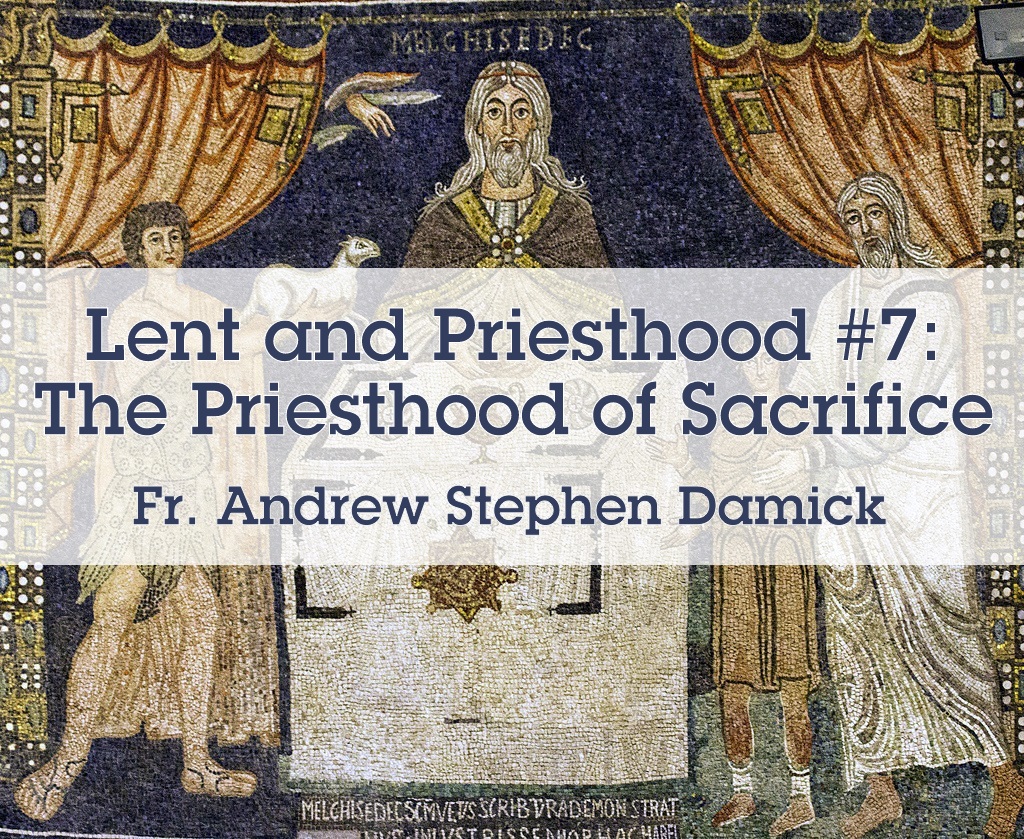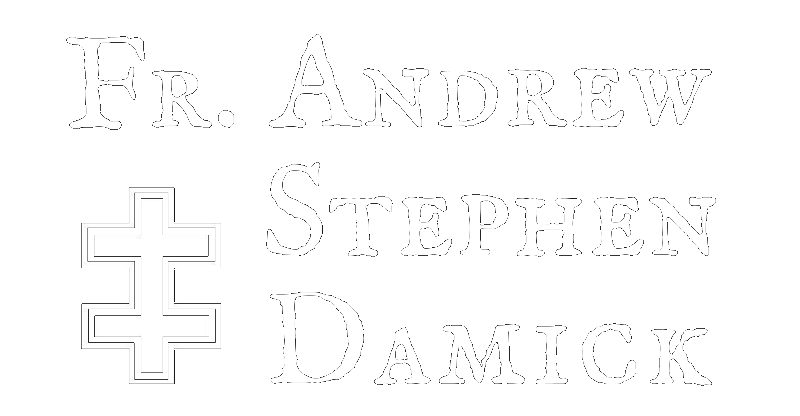
Sunday of the Adoration of the Holy Cross, March 19, 2017
Hebrews 4:14-5:6; Mark 8:34-9:1
Very Rev. Fr. Andrew Stephen Damick
In the Name of the Father and of the Son and of the Holy Spirit, one God. Amen.
The Sunday of the Cross is one of the great high points of the holy season of Lent, and so it is appropriate that in our extended meditation on the priesthood during this season that we reach a high point in that, as well. For today we gaze upon the crucified Jesus Christ, lift high His cross, and place our hope in the priestly work accomplished there.
We have said that there are three kinds of priesthood that we are contemplating this season—the High Priesthood of Jesus Christ, the ordained priesthood of our bishops and presbyters and the royal priesthood of all Orthodox Christians. But today above all else we consider the High Priesthood of Christ.
The reading we hear from Hebrews underscores this focus with its beginning: “we have a great High Priest, who has passed through the heavens, Jesus the Son of God.” The whole book of Hebrews is about priesthood, but it is most especially about the priesthood exercised by Jesus Christ, the Son of God.
This verse says that He has “passed through the heavens,” which is not only a reference to His ascension but also to His priesthood. Why? It is because one of the actions known to the Jews to whom this epistle is addressed is the action of a priest passing through a veil in order to enter into the Holy of Holies in the Temple. Priests pass through a veil in order to complete the work of the priesthood. So, too, did Jesus pass through a veil—in this case, the veil of the heavens—to complete His priestly work.
But we are not primarily thinking today of His ascension but of the priestly act upon the cross. The reading from Hebrews goes on to speak of how the high priest is taken from among the people so that he may offer up sacrifices for sins. This is Jesus, Who is indeed of God but also is one of us. We say that He is “consubstantial” or “of one essence” with the Father, but He is also of one essence with us human beings. He is taken from among us for this priestly act of sacrifice.
And His whole life is sacrifice. This is why He came. And what is sacrifice? It is to offer something up to God, which is then acted upon by God, changed by Him, charged with His presence, and then returned to us for our communion and sanctification. So this applies to the whole life of Jesus. How?
When He comes down from heaven and is incarnate of the womb of the Virgin Mary, He is offering up His own Godhood in self-emptying. And while His deity is unchanged in what He is, His deity is now nevertheless connected forever to mankind in His humanity. He empties Himself and offers Himself even while remaining perfectly God. He descends from heaven even while remaining in Heaven. And this is for us.
And as He grows, He offers up His divine-human life, providing sanctification for every part of what it means to be human. He is an infant, a child, a boy, a teenager, a young man and a fully grown man. All the stages of His life are sacrifice. All the stages of His life provide an offering that we can connect with, partake of, identify with, and be changed by.
And He offers up His teaching and His healing as a sacrifice, as well. He does not do these things for Himself or in an act of self-fulfillment. It is all a sacrifice, all an offering. And His words and His touch, being charged with the power of God, grant transformation and healing to those who receive them.
But then finally, His whole life is summed up in this great act of priestly offering, the greatest act of sacrifice that there is—He offers up His very life on the cross. He gives Himself as the offering sacrificed on the altar of God. No more lambs, no more goats, no more bulls. Just Jesus, the once-for-all-time sacrifice given for our sake.
But in this moment, the whole narrative is changed. He is not the sacrifice offered up to death that is changed by being sacrificed. It is not He Who is changed. Rather, He is the sacrifice that changes that to which He was offered. When His life is given over to death, it is death that is changed. It is death that is radically transformed on that altar. It is death that now gives life!
Sacrifice will never be the same again. Why? It is because this is not truly a human sacrifice. This is not one man who is being killed in order to appease a god. This is the one God of the universe giving Himself as a sacrifice. This is one of the Trinity suffering in the flesh. This is the God Who is Life Himself entering into death—death which is His opposite, death which is the last enemy of the creation, death which is the negation of every good that comes from God.
And it is death that is changed. It is sacrifice itself that is changed. This is no normal sacrificial victim. This is a sacrifice that takes over the whole action and radically alters its inner character. Death has now been inverted. Death has been made to work backward. Death has been put into the service of life!
The high priest Jesus Christ Who approaches the altar that is the cross approaches it in order to offer up Himself. He is borne there to the altar by His mother, by His disciples, by the angels, by His Father, by the Holy Spirit, by the whole human race that gave to Him His flesh, by the whole creation that serves Him. And He then offers Himself. He places Himself on the altar. He sacrifices Himself. He is the Offerer and the Offering. He is the Sacrificer and the Sacrifice. He is the One Who also accepts the offering and distributes it.
He distributes this offering as food to the faithful. He feeds this offering to the faithful for their sanctification, for their forgiveness, for the restoration of communion with God, for the healing of soul and body, for eternal life, for resurrection, for love, for faith, for hope, for blessing, for growth, for comfort, for union, for joy, for holiness, for perfection.
When we see Him lifted up upon the cross, we do not see a victim of the violence of mankind. We see a priest Who is giving Himself as a sacrifice on the altar. We see a sacrifice given over to death and received back again as life.
This is the very heart of the priesthood, of all priesthood. This is what Jesus Christ came to this earth to accomplish. And when He had accomplished it, He said, “It is finished” (John 19:30). And it was then at that moment that He gave His life. And that was the moment when death began to be destroyed, when the grave became the source of life.
It is therefore from this priestly act of Jesus Christ that we also have the work of the ordained priesthood. It is the task of our bishops and priests to offer up sacrifices that turn death into life, that turn what is sacrificed into what sanctifies and heals.
And this is the same priestly act given to all the royal priesthood. We as Christians have the task of seeking out death and turning it to life. We offer up what is given on God’s altar, speak the words of prayer given to us as priests, and then distribute what has been changed in order to bring all the good things of Christ’s presence to ourselves, our families and all those around us. The best way we do that is through our prayers. But we also seek out all other ways we can, as well.
Today we look upon the crucified Jesus Christ and stand in awe at His act of priestly self-sacrifice—the God-man upon the cross, the Author of Life given over to death. This is the priesthood of sacrifice. And we also take up our own crosses and follow Him in the way of sacrifice until we all come to the resurrection.
To our High Priest Jesus Christ Who offers Himself, with His eternal Father and His all-holy and good and life-giving Spirit, be all glory, honor and worship, now and ever, and unto ages of ages. Amen.




Probably totally off-topic, but, nevertheless, inspired by this homily: it is the sanctifying Spirit-fire within us that makes us immune to the consuming Fire of the end of this age.
Lord, have mercy.
Father Andrew,
Thank you. Your Lent and the Priesthood series have been so very helpful in understanding how sacrifice, offering, union, and communion are intertwined. When you began to describe Christ’s sacrifice of death “And it is death that is changed. It is sacrifice itself that is changed.”, is where for me it ‘clicked’ and all fell into place. Much appreciated, Father!